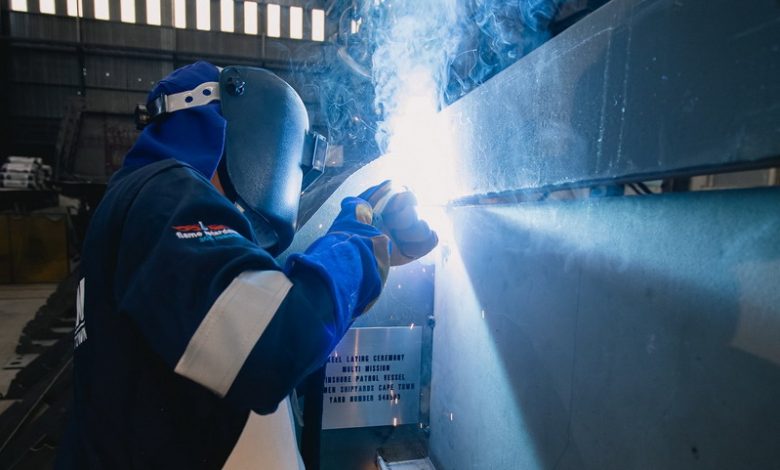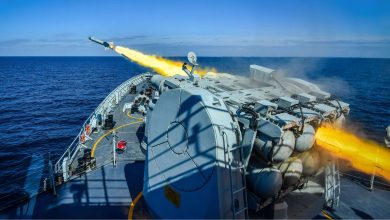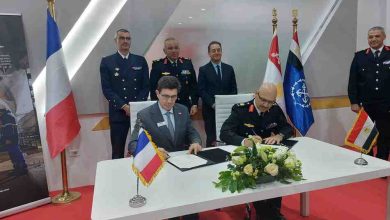
Damen Shipyards Cape Town Marks Milestone with Keel Laying of Third SA Navy MMIPV
On 22 October, Damen Shipyards Cape Town (DSCT) celebrated a keel-laying ceremony for the third Multi-Mission Inshore Patrol Vessels (MMIPV) that DSCT is constructing for the South African Navy as part of Project Biro.
The ritual includes placing a newly minted coin on the keel and then constructing over it. The coin laid during the DSCT ceremony was a commemorative medal honouring the late President Nelson Mandela’s 1993 Nobel Peace Prize victory. It was positioned on the keel by the Chief of the SA Navy, Vice Admiral Mosiwa Hlongwane. Subsequently, the keel bar was set atop the coin and welded into the structure – a privilege bestowed upon Lucian Norman, a second-year apprentice at Damen’s training institution, which has educated over 200 youths from previously disadvantaged backgrounds since its establishment in 2010.
During the occasion, CEO of Armscor, Advocate Solomzi Mbada, remarked, “The acquisition strategy for this project incorporated Commercial-Off–The-Shelf (COTS) equipment, alongside adherence to the DTI (Department of Trade and Industry) 60% local content shipbuilding specification, Defence Industrial Participation (DIP), and National Industrial Participation (NIP). This approach assured that Armscor could maximize local engagement and guarantee that the vessels could be supported domestically, thus reducing the life cycle support expenses. Additionally, this strategy served as a catalyst for the shipyard to enhance its local infrastructure and invest in human resources, generating essential jobs to stimulate the South African economy and alleviate the high unemployment rate.”
“I wish to express my gratitude to the DSCT team for ensuring that the specifications articulated by the South African Navy have been met. In the face of the challenges posed by COVID-19, you have excelled,” Hlongwane commented.
DSCT’s managing director, Jankees Trimpe Burger, stated, “The project exemplifies Damen Maritime Security Solutions in action. Through this initiative, Damen not only provides a vessel but also an integrated maritime solution, encompassing all facets of vessel operation throughout its lifecycle, alongside a contribution to a sustainable maritime industry within the region it serves.”
Damen reported that it has fulfilled NIP, DIP, youth employment, local content, and other stipulations in the Biro project and has generated over 300 direct jobs and more than 1,000 indirect jobs, in alignment with the South African Government’s Operation Phakisa objectives.
The trio of new MMIPVs will operate as Warrior Class vessels, acknowledging the warriors who bravely led their communities in numerous historical battles across South Africa.
SAS Sekhukhune (P1571) will be the first MMIPV to be operational next year. The initial hull was launched at Cape Town’s V&A Waterfront in March this year, before being relocated to the Elliot Basin for additional fitting and finishing. The other two MMIPVs are SAS Adam Kok (P1572) and SAS Shaka (P1573). The keel for the second vessel was laid in August 2020.
The vessels supplied by DSCT follow the Stan Patrol 6211 design. They have an overall length of 62 meters, a top speed of 26.5 knots, a range of 4,000 nautical miles, and can accommodate a crew of up to 62 personnel. Each vessel will also carry one 7-meter long RHIB and one 9-meter long RHIB for boarding operations.
Damen stated that the vessels for Project Biro are specifically designed to meet the requirements of the South African Navy and include the Damen Sea Axe Bow – a vertical hull form that mitigates slamming for safer, more comfortable operations in turbulent seas. These multi-mission inshore patrol vessels are the inaugural Sea Axe vessels to operate in South Africa.







